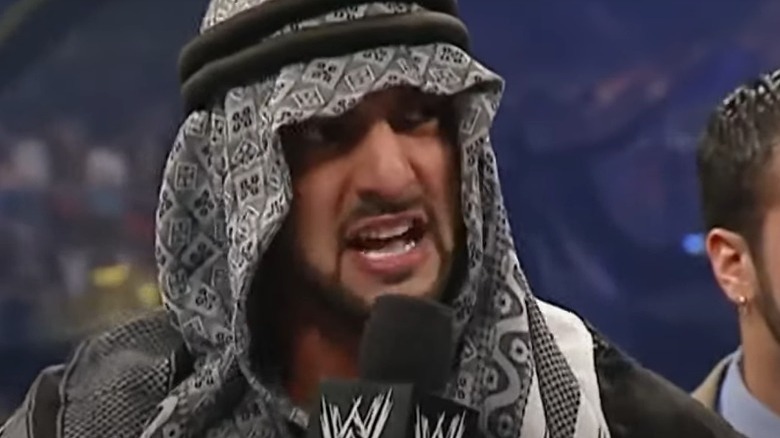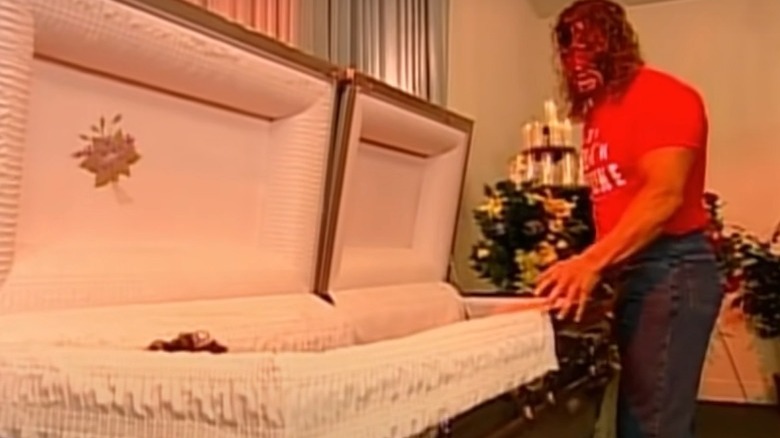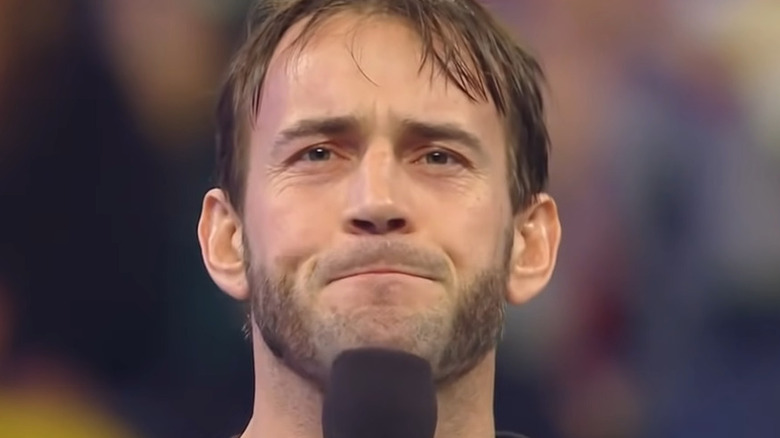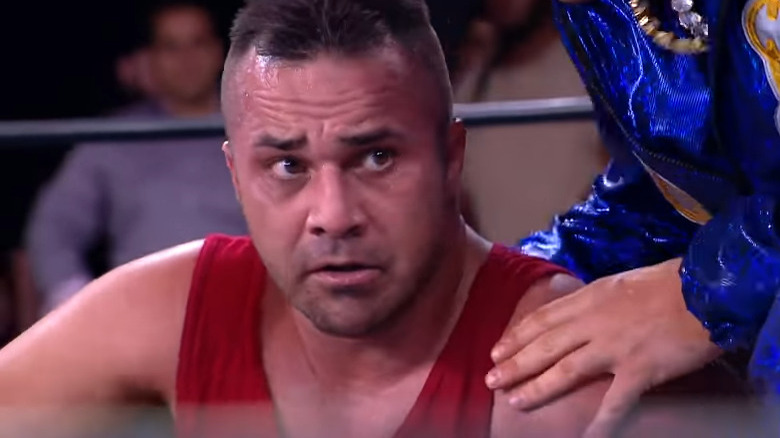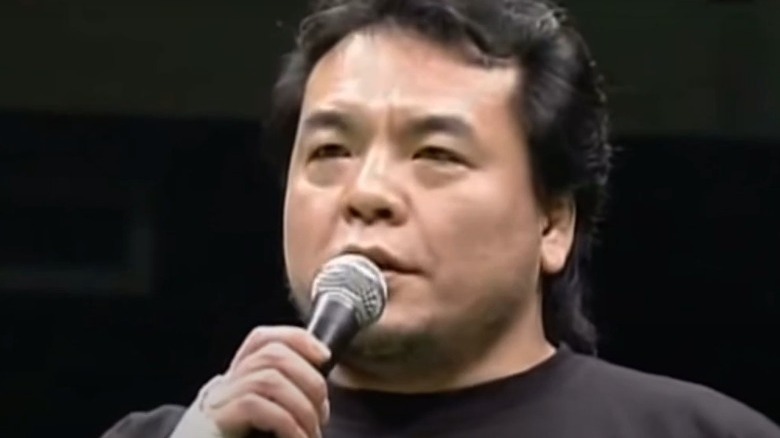Wrestling Moments Promotions Wish You'd Forget
A lot of moving parts must come together for the average wrestling show to go smoothly. Matches, entrances, promos, camera angles, commentary, and more all have to work in unison for things to unfold as intended. For the most part, promotions have this down to a science, amounting to consistently well-put together shows that go off without a hitch by the time the main event concludes. However, it's not uncommon for things to go awry once in a blue moon.
As a consequence of being such a complicated form of entertainment, pro wrestling has the potential to go off the rails in a variety of ways. Perhaps a match doesn't proceed as planned, resulting in a wrong finish or worse, an injury. Maybe the sound department plays the wrong entrance theme for a wrestler and confuses the entire arena. A multitude of things can go wrong at wrestling events, and fans know this. Oftentimes it's nothing too harmful and folks write it off as a flub and move on. Occasionally, though, it's something entirely different.
Over the years, certain in-ring moments, stories, and more have become so infamous that the promotions that hosted them are desperate for the world to forget they ever happened. Here are some of the most noteworthy examples.
WWE: Muhammad Hassan's brief SmackDown run
In late 2004, WWE introduced a character named Muhammad Hassan, an Arab American who wasn't afraid to speak his mind when it came to the United States media's depiction of his culture following 9/11. Accompanied by Daivari, he'd quickly find himself engaged in major feuds on "Raw" with the likes of Batista, Shawn Michaels, and Hulk Hogan. Hassan even almost became the WWE Intercontinental Champion, though repeatedly failed to capture the gold. As part of the 2005 WWE Draft, he and Daivari jumped to "SmackDown," where he'd begin a rivalry with none other than the Undertaker.
Ahead of his match with Hassan at The Great American Bash, Undertaker faced Daivari one-on-one on the July 7, 2005 edition of "SmackDown." After defeating his opponent, Taker watched as Hassan summoned five masked men, who brutally attacked him so that Hassan could apply his signature move, the Camel Clutch. The episode — taped on July 4 — aired on the same day that the London bombings took place, which killed over 50 people and injured roughly 700. The close proximity of the Hassan-Undertaker segment to the attacks generated a media uproar that led to UPN (the network "SmackDown" aired on) telling WWE to pull the plug on the whole angle (as Shawn Daivari recalled on the "House of Hardcore" podcast).
Undertaker and Muhammad Hassan would square off at The Great American Bash as planned, but after a Last Ride through the entrance stage, Hassan was never seen nor heard from on WWE programming again. WWE has seldomly — if ever — spoken of him following his disappearance from TV and subsequent release from his contract.
Ring of Honor and New Japan Pro Wrestling: Enzo Amore and Big Cass' G1 Supercard run-in
Enzo Amore and Big Cass were a hot commodity throughout their time as a tag team in WWE. As part of the "NXT" and later "Raw" rosters, they knew how to get audiences on their feet with their exciting promos and matches. After a rather brief run on "Raw" as a team, the two became rivals before Amore moved to "205 Live." Not long after winning the WWE Cruiserweight Championship, sexual assault allegations caused Amore to be suspended and eventually released from WWE in January of 2018 (via USA Today). Big Cass left the company that June, detailing a myriad of personal issues as the reasons behind his exit.
In the wake of their WWE departures, Cass and Amore went their separate ways professionally until April 6, 2019. The duo appeared in the crowd at the G1 Supercard event put on by Ring of Honor and New Japan Pro-Wrestling, but they didn't stop there. Cass and Amore jumped the barricade and got into a scrap with Jay and Mark Briscoe as well as Bully Ray, which wasn't shown in any capacity that night as noted by the Wrestling Observer. Still, security didn't attempt to stop them, indicating that their run-in was planned despite the fact that nothing ever came of it — a fact that Amore has been quite vocal about in the years since.
It still remains a mystery what was supposed to come of Big Cass and Enzo Amore's G1 Supercard appearance, and as evidenced by the fact that neither ROH nor NJPW has gone back to it, it's likely we'll never know the full story.
WWE: The Katie Vick angle
At the end of 2002, Triple H began his infamous "Reign of Terror" atop the "Raw" brand as the WWE's inaugural World Heavyweight Champion. Throughout the next few years, the "King of Kings" would take part in feuds with the very best that the flagship program had to offer, including Rob Van Dam, Booker T, and even his former D-Generation X teammate, Shawn Michaels. Most of these rivalries ranged from decent to incredibly entertaining, but one of them stands out from the pack all these years later due to its controversial nature: Triple H's storyline against Kane, better known colloquially as the Katie Vick angle.
Kane and Triple H's feud kicked off in October of 2002, and it didn't take long for it to go in a baffling direction. According to Triple H, years before Kane arrived in WWE, he was particularly close with a woman named Katie Vick. One night, Kane supposedly had too much to drink, yet he tried to drive himself and Katie home from a party. Not only did this lead to a car accident and her death, but per Triple H's "sources," Kane did unspeakable things to her body shortly after her passing. To further get under his opponent's skin, Triple H put together a tape mocking the latter point that immediately went down as one of WWE's most tasteless moments.
Even back then, Kane and Triple H were both already legends of WWE and pro wrestling as a whole. Still, the Katie Vick story did neither of their legacies any favors. In light of negative fan reactions, WWE quietly put the angle to bed after their No Mercy 2002 match and has rarely highlighted it after the fact.
Impact Wrestling: Roddy Piper's 2002 shoot promo
Impact Wrestling — then known as National Wrestling Alliance: Total Nonstop Action (NWA-TNA) — opened for business in 2002 as an alternative for fans and wrestlers alike. A breath of fresh air compared to WWE, TNA offered viewers intense matches with upstarts such as AJ Styles, Elix Skipper, Christopher Daniels, and numerous others seeking to make it big in the wrestling game. At the same time, the minds behind TNA knew that established wrestling stars were necessary to get skeptical viewers to check out the product. Alongside the likes of Jeff Jarrett and Ken Shamrock, the legendary "Rowdy" Roddy Piper added his name to the TNA roster and debuted in December of 2002.
Known around the world for his wild yet sharp promos, Piper's first appearance in a TNA ring promised some of his signature mic work. However, the seasoned veteran of the squared circle took this promo in an uncomfortable direction. As a part of his burgeoning feud with Vince Russo — with whom Piper worked in World Championship Wrestling years prior — he seemed to take a typical promo and go "off-script." The worst part came when he blamed Russo for the tragic death of Owen Hart in 1999 and invoked the names of several other deceased wrestling stars in an effort to prove how dangerous Russo is to professional wrestling.
All in all, it's clear that this promo was designed to put some heat on Vince Russo and make Roddy Piper the clear babyface in their rivalry. That said, this segment is difficult to watch, as real-life deaths are used to advance a fictional wrestling story. This one doesn't often make Impact Wrestling's modern highlight reels.
AEW: Matt Hardy's injury at All Out 2020
All Elite Wrestling got its start in 2019, breathing new life into the professional wrestling landscape. With a stacked roster, a television deal with TBS, and legions of fans ready to pledge their support to it, AEW got off the ground with few hiccups. At the same time, as a brand new promotion, maintaining its image was paramount to its success if those behind it truly wanted to compete with the WWE. Any missteps as it found its niche would hurt its chances of success immensely, as evidenced by Matt Hardy's injury during his match with Sammy Guevara at the 2020 edition of AEW All Out.
Competing under Broken Rules (effectively a last man standing match), Hardy and Guevara brawled throughout the Daily's Place Amphitheater in Jacksonville, Florida. The condition was that if Hardy lost, he'd have to leave AEW, so he fought especially hard to defeat Guevara. The most infamous moment of the match came when the two men battled atop a lift before crashing through a table on the ground below. When Hardy went down, though, his head smacked against the bare concrete below. He received emergency medical attention and the match continued, with Hardy ultimately standing victorious.
Throughout his career, Matt Hardy has taken some scary bumps, and while he feels this one isn't his worst, it brought a lot of negative attention to AEW all the same. Allowing the match to continue as the full extent of his injuries remained a mystery wasn't a great look for such a young company or the folks behind it.
WWE: CM Punk's walkout
CM Punk was one of WWE's hottest commodities throughout the 2010s, thanks in large part to his famous "Pipe bomb" promo from 2011, where he got candid about Vince McMahon, his treatment in the company, and more. This new "Voice of the Voiceless" character propelled Punk to new heights and even led to him becoming one of the longest-reigning WWE Champions of the modern age. Be that as it may, when it came to what he had to deal with behind the scenes, he couldn't have been more frustrated. Thus, he reached his breaking point in 2014 and threw caution to the wind for the sake of his health, sanity, and career.
In January of 2014, CM Punk took part in WWE's annual Royal Rumble match, which turned out to be his final appearance in the company. A few days later, the news broke that he decided to walk away from WWE for reasons that would be explored by the man himself on fellow wrestler Colt Cabana's "The Art of Wrestling" podcast in December of that year. As he revealed, supposed negligence on WWE's part toward his work-related health problems, tensions with talent, issues with the corporate structure, and more factors stretching back to before WrestleMania 29 all contributed to his sudden exit.
Years have passed since Punk's departure from WWE and aside from appearances on "WWE Backstage" — a show run through Fox and not technically through WWE — he's shown no interest in returning. WWE has hardly spoken of the "Second City Saint" and rarely show him in archival footage. Not to mention, his presence on AEW has made those in charge even less keen on covering his time in the company and subsequent walkout.
Ring of Honor: The 2003 Teddy Hart incident
Professional wrestling is home to more than a few famous families, with one of the most well-known being the Harts. Its members, including Stu Hart, Bret "The Hitman" Hart, and Owen Hart, have found success in the squared circle for decades across numerous promotions. One name that infrequently comes up when assessing the Hart lineage is Teddy Hart, who got his start in the 1990s and has found minimal success compared to some of his family members. It likely doesn't help that he became quite the controversial figure early on in his career, most notably under the Ring of Honor banner.
After getting his start in WWE, Hart left before wrestling a single match for the company. He then jumped to Ring of Honor in September of 2003, which was still in the process of finding its bearings just shy of two years into its existence. By November, Hart already got on the bad side of many behind the scenes when he participated in a scramble cage match and took matters into his own hands after the bout concluded. He performed several unplanned moves that put his fellow wrestlers in harm's way and threw up at ringside mere moments later. He reportedly suffered a concussion during the match.
To put it lightly, his fellow ROH stars weren't happy with his antics, especially CM Punk, who called Teddy Hart out for his actions in a LiveJournal post at the time and later got into a backstage fight with him in TNA. In the aftermath, Hart was banned from ROH and wouldn't appear for the promotion again until 2009. All in all, this situation didn't do anyone any favors and is far from a proud moment in ROH history.
Impact Wrestling: Scott Hall's Turning Point 2007 no-show
With the 2010s coming into view, TNA had really started to hit its groove. Now on Spike TV, more eyes than ever were on the product, eager to see what kind of action would take place in the six-sided ring week after week. Still, despite this increasing success and the rise of homegrown talent, those in charge at TNA continued to keep a steady supply of wrestling icons on the roster for fans who just wanted to see the stars of yesteryear. One such signing was the late WWE and WCW legend Scott Hall, who appeared sporadically for the company from 2002 to 2010.
In December of 2007, plans were in place for Hall and longtime tag team partner and personal friend Kevin Nash to team up with Samoa Joe against Kurt Angle, AJ Styles, and Tomko at Turning Point 2007. However, when the pay-per-view finally arrived, TNA fans would not get their promised Outsiders reunion, as Hall no-showed and cited food poisoning as the reason why. Unsympathetic to the situation, Joe cut a scathing unscripted promo on Hall, calling him out for his lack of attendance when he and other up-and-coming TNA stars wouldn't dare do the same. As he explained on "The Kurt Angle Show," this cooked up some serious tension between him and Nash.
No-showing events is very much frowned upon in pro wrestling, even if your name's Scott Hall. Samoa Joe wasn't afraid to highlight that in his promo despite the heat it put on him and the fame of the person he directed it at. It was an overall bad situation that Impact Wrestling have been wise to retread.
Impact Wrestling: Jeff Hardy's appearance at Victory Road 2011
Throughout his wrestling career, Jeff Hardy has pretty much done it all. He's won several world championships, taken part in some of the most memorable rivalries of all time, and put on countless classic matches that will never be forgotten. At the same time, Hardy has had to deal with his fair share of personal problems, specifically drug and alcohol addiction — the latter of which continues to plague him in the present day. For the most part, he hasn't brought such issues to the ring, but when he did, he put himself at the center of one of the most infamous moments in TNA history.
At Victory Road 2011, Jeff Hardy was set to face "The Icon" Sting in hopes of regaining his lost TNA World Heavyweight Championship. From the moment he stepped into the arena, though, something was clearly wrong. As it turns out, Hardy was under the influence of muscle relaxers (as he explained on the "Art of Wrestling" podcast), prompting Eric Bischoff to come out, add a no-disqualification stipulation to the match, and inform both men how to proceed. Under two minutes later, Sting forced a pinfall on Hardy and walked back up the ramp as fans shouted their disapproval. Frustrated, Sting vocally agreed with their anger.
Wrestling fans continue to talk about Jeff Hardy vs. Sting at Victory Road 2011 all these years later, and it's easy to see why. It feels like a moment that shouldn't have happened, and yet it did. Luckily for all parties involved, it went about as well as it could have given the circumstances, but it's a black mark on Hardy's legacy and Impact Wrestling's image all the same.
If you or anyone you know is struggling with addiction issues, help is available. Visit the Substance Abuse and Mental Health Services Administration website or contact SAMHSA's National Helpline at 1-800-662-HELP (4357).
Pro Wrestling NOAH: The death of Mitsuharu Misawa
Mitsuharu Misawa first stepped into a wrestling ring in the early 1980s, and it didn't take him long to earn a reputation as one of the best in the world. One of All Japan Pro Wrestling's brightest stars, he'd feud with the likes of Jumbo Tsuruta and Toshiaki Kawada, put on some of the most thrilling matches in pro wrestling history, and accumulate quite the impressive collection of championships and accolades. By the new millennium, however, he'd make a major career change by leaving AJPW behind to form his own promotion, Pro Wrestling NOAH, where his illustrious career would come to an unexpectedly tragic end.
On June 13, 2009 — a mere few days shy of the ninth anniversary of Pro Wrestling NOAH's establishment — Misawa teamed with Go Shiozaki against Akitoshi Saito and Bison Smith in a match for the Global Honored Crown Tag Team Championship. All proceeded as planned until Saito hit Misawa with a back suplex, which knocked the wrestling legend unconscious (via ESPN). The match eventually stopped and ringside doctors attempted to revive Misawa, but their efforts couldn't save his life. He was then rushed to the hospital and declared dead at the age of 46.
Mitsuharu Misawa will undoubtedly go down in history as one of the greatest to ever lace up a pair of boots. His in-ring work has inspired so many over the years and will continue to do so for years to come. It's just too bad that he didn't get to finish his career on his own terms. Being such a well-known wrestler and the company's founder, it makes sense that NOAH wouldn't go out of its way to discuss his final match.
The Crash: The death of Perro Aguayo Jr.
The late Perro Aguayo is a tremendously influential name in the history of pro wrestling. That meant that his son, Perro Aguayo Jr., had some huge shoes to fill when he started wrestling in the mid-1990s, but he didn't let his father's legacy intimidate him. He'd enjoy a great career of his own that saw him win a handful of championship titles and work against the best that stepped into the rings of AAA, Consejo Mundial de Lucha Libre, and more — until it was tragically cut short.
Aguayo Jr. teamed with Manik on March 20, 2015 against Rey Mysterio Jr. and Extreme Tiger at an event for The Crash Lucha Libre. It seemed like business as usual until Mysterio set up Manik and Aguayo Jr. for his famous 619 maneuver. He dropkicked the latter in the back to set him into position for the move, though his body immediately went limp and he became unresponsive. Ernest Franco of the Tijuana Wrestling Commission later revealed (via the Los Angeles Times) that the kick broke his neck and caused a cervical stroke that led to a heart attack, killing Aguayo Jr. at the age of 35.
"When I meet great people in this industry, I like to let them know they are great human beings. Perro was definitely one of them. He was so warm-hearted, kind, and respectful," Mysterio said to Sports Illustrated of Perro Aguayo Jr., referring to him as one of Mexico's biggest stars. It's a shame that the manner of his death will always hover over his numerous accomplishments and overall impact on the wrestling world, in addition to The Crash itself.
WWE: The death of Owen Hart
Owen Hart has earned his place among the all-time wrestling greats for more reasons than one. He had plenty of charisma, made the most of every gimmick handed to him, and, perhaps most crucially, he was a technical mastermind in the ring. Whether he stood toe-to-toe with "Stone Cold" Steve Austin or his own brother, Bret "The Hitman" Hart, he made it his mission to put on the best match possible — using his infectious personality to perfection to bolster fan investment. Sadly, the circumstances surrounding his death in 1999 have made it difficult to look back on his incredible life and career in such a positive way.
On May 23, 1999, Kansas City, Missouri hosted the World Wrestling Federation's Over the Edge pay-per-view, which would showcase Owen Hart — competing under his superhero-esque Blue Blazer persona — against the Godfather for the Intercontinental Championship. During his entrance, Hart would descend from the arena ceiling via a cable and harness, but the situation would quickly turn dire. The cable disengaged from the harness, causing Hart to fall from a height of nearly 80 feet down to the ring below. He was quickly rushed to the hospital where the staff did all they could to help, but they were unsuccessful. Hart was pronounced dead that night at the age of 34.
Owen Hart's fall was not broadcast as part of Over the Edge, so the only people who witnessed it were those in attendance. No footage of it has surfaced online and it likely never will, especially not from WWE. The company has done as much as possible to avoid recounting Hart's death in any form, and considering negative media attention that it created — along with heavy scrutiny from Hart's widow Martha – those in charge would prefer fans didn't talk about it.

